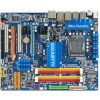- Qualcomm Launches Snapdragon 4 Gen 2 Mobile Platform
- AMD Launches Ryzen PRO 7000 Series Mobile & Desktop Platform
- Intel Launches Sleek Single-Slot Arc Pro A60 Workstation Graphics Card
- NVIDIA Announces Latest Ada Lovelace Additions: GeForce RTX 4060 Ti & RTX 4060
- Maxon Redshift With AMD Radeon GPU Rendering Support Now Available
Gigabyte EP45-UD3P

Looking to build a new machine on a budget? Then look no further than choosing Gigabyte’s EP45-UD3P as your choice for motherboard. It may not offer a lot in the area of bling, but it includes a solid design, lots of connectivity (including 8 USB and S-ATA), fantastic overclocking potential and best of all, it comes in at an average price of $115.
Page 7 – Gaming: Call of Duty 4, Half-Life 2: Episode Two
Crysis Warhead might have the ability to bring any system to its knees even with what we consider to be reasonable settings, but Call of Duty 4 manages to look great regardless of your hardware, as long as it’s reasonably current. It’s also one of the few games on the market that will actually benefit from having a multi-core processor, although Quad-Cores offer no performance gain over a Dual-Core of the same frequency.
For our testing, we use a level called The Bog. The reason is simple… it looks great, plays well and happens to be incredibly demanding on the system. It takes place at night, but there is more gunfire, explosions, smoke, specular lighting and flying corpses than you can shake an assault rifle at.

Half-Life 2: Episode Two
The original Half-Life 2 might have first seen the light of day close to four years ago, but it’s still arguably one of the greatest-looking games ever seen on the PC. Follow-up versions, including Episode One and Episode Two, do well to put the Source Engine upgrades to full use. While playing, it’s hard to believe that the game is based on a four+ year old engine, but it still looks great and runs well on almost any GPU purchased over the past few years.
Like Call of Duty 4, Half-Life 2: Episode Two runs well on modest hardware, but a recent mid-range graphics card is recommended if you wish to play at higher than 1680×1050 or would like to top out the available options, including anti-aliasing and very high texture settings.

Once again, results are as we expected. No board excelled in any benchmark, gaming included, which is a good thing. You don’t really need a top-of-the-line motherboard for improved gaming performance, and that’s how it should be. Next up, overclocking.
Support our efforts! With ad revenue at an all-time low for written websites, we're relying more than ever on reader support to help us continue putting so much effort into this type of content. You can support us by becoming a Patron, or by using our Amazon shopping affiliate links listed through our articles. Thanks for your support!







